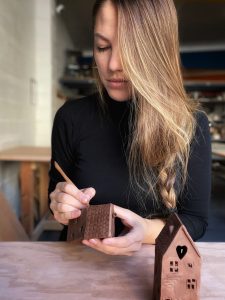 Today we’d like to introduce you to Milla Istomina.
Today we’d like to introduce you to Milla Istomina.
Hi Milla, it’s an honor to have you on the platform. Thanks for taking the time to share your story with us – to start maybe you can share some of your backstory with our readers?
Thank you for having me! It’s an honor! I grew up in a creative wonderland. My mom, being an artist and a designer always encouraged us to create and try new things. You could find all sorts of paints in our house, fabrics, yarns, laces, macrame workbooks, pearls, woodwork, and flower making tools. Needless to say, most, if not all the gifts we gave to our parents when we were kids were handmade.
My first experiments sculpting involved modeling clay or clay we picked up on a riverbank. The latter was an absolute delight to work with; although I could not fire it in the kiln, I could dry it in the sun and paint using gouache paints. The metamorphoses materials undergo from being a lump of clay to an object one can observe, recognize, and hold are fascinating. I think it’s a common thing with people of my generation, we are so estranged from the results of our work, given that so much of what we do isn’t tangible, we find craftsmanship akin to magic. In 2018 I treated myself to a wheel-throwing class at the Barnsdall Art Center. It’s a local art studio, and they offer classes in a great variety of disciplines at a very modest price range. It was nearly nine months after my first lesson when my first off-center, clumsy, and topsy-turvy pieces made it to my friends and family. I became a member at a local studio with 24-hour access to follow my teacher’s instruction of practicing more, and so my pottery journey kicked off.
Alright, so let’s dig a little deeper into the story – has it been an easy path overall and if not, what were the challenges you’ve had to overcome?
Apart from occasional sales on the markets and fairs, I used to sell a few pieces online. When the sales were enough to cover my monthly studio and materials/tools fees, I was over the moon happy. As hobby pottery is quite expensive. The majority of my pieces were given away, and some did not pass quality control. I learned that the earlier in the making process, I can identify and discard poor quality make, the easier it is for me to start over and make a better attempt. In March 2020, when it became clear that I am likely to lose my full-time job (I worked in a marketing team for an arts organization, and 2020 was no friend to public events and shows) I began to think that it was time to take more decisive steps towards promoting my own product. Lockdown, in a way, was the reason I finally got to take my pieces out of the boxes, photograph them, and put them on Etsy.
I had all the time in the world and no excuses for not doing it. I also brought home a bag of clay and in one corner of my kitchen made some handbuilt vases, pendants, and figurines. The cat figurines later became what is now known as my “Cat in the Box” project. In June, when I indeed lost my job I felt like my ceramics business stood a chance at keeping me afloat for a little while. It was just essential to philosophize over the state of things less and work more. The fact that so many people wanted to purchase my ceramics was absolutely overwhelming. I can’t thank my customers enough, who unbeknownst to themselves, helped me through the toughest time in my work life. After moving to the US this was probably the most challenging experience.
Can you tell our readers more about what you do and what you think sets you apart from others?
My work mostly consists of throwing on the wheel and slab construction hand-building. I don’t really have a preference and find both techniques very enjoyable. The technique is primarily determined by the type of product. I am more comfortable making my tableware on the potter’s wheel, while some pieces are exclusively hand-built. Etching, sgraffito, and underglaze painting are some of my favorite decorative techniques.
My shop currently carries a series of products I replenish on a regular basis, but I also experiment a lot, so there are always one of a kind items. I am also always excited about commissions. I feel incredibly special when people trust me to create unique artworks for them and their loved ones. At this point working on as many challenging projects as possible is crucial. It helps me shape my personal style and brand.
What’s next?
Ceramics requires a lot of practice, and it’s a kind of process where shortcuts and guessing simply don’t work. Working with clay is always a humbling experience. Producing items takes patience, strength to try over and over, and ingenuity. I still don’t have a lot of experience, and If someone told me two years ago that I would be selling my work, I’d only laugh. I intend to learn as much as I can and try the many tools and techniques at my disposal. There is something I jokingly call “potters’ fever”, for when someone first gets into pottery, then slowly starts exploring the many possibilities of clay, until it doesn’t excite them enough, and they get into experimental firings, mixing their own glazes and making their own tools. I think I can recognize the “symptoms”. Since becoming a studio member, there are only two types of days in my week that truly matter: the days when the kiln is being loaded and the days it is being unloaded. But processing orders, managing social media channels, photographing ceramics take a lot of time, and if no timeslot was allotted for these tasks, I have to get to them after 7-10 hours in the studio. I am yet to learn to manage my time better.
Contact Info:
- Email: [email protected]
- Website: http://mistceramics.etsy.com/
- Instagram: https://www.instagram.com/m.istceramics/
- Facebook: https://www.facebook.com/mistceramics/
- Twitter: https://twitter.com/CeramicsMist
- Other: https://www.pinterest.com/ceramicsmist/


























